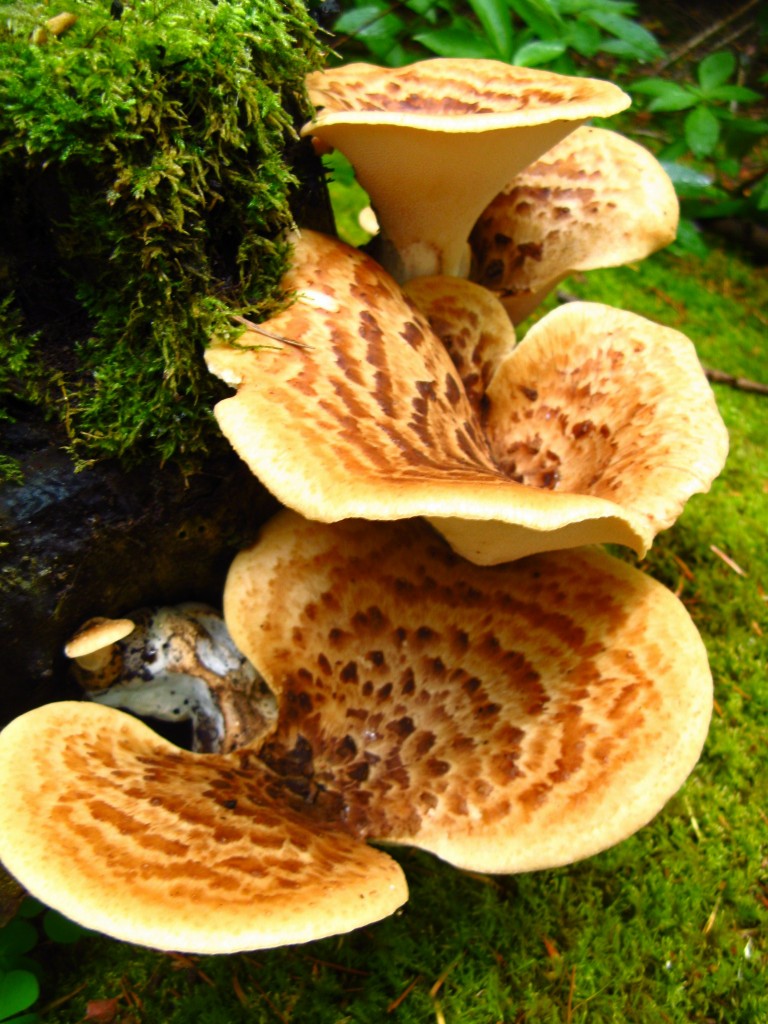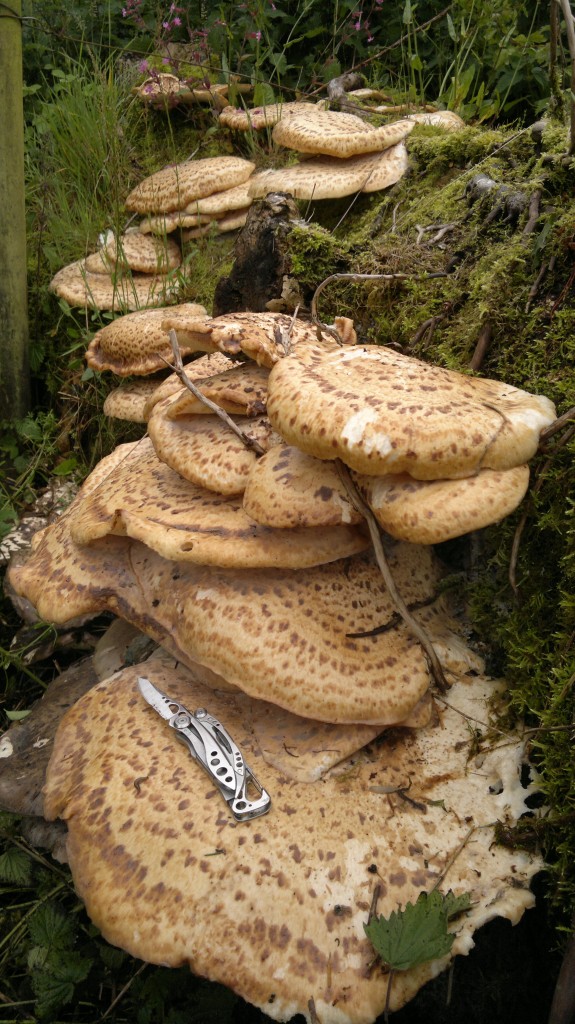Dryad’s Saddle – Edibility, Identification, Distribution
Cerioporus squamosus
(Until recently known as Polyporus squamosus)
AKA Pheasant mushroom, Pheasant back
- Edibility – 1/5 – young succulent specimens only – you really need to catch them early before before they get tough and indigestible. That normally means before the brackets are more than about 6cm across. Be on the ball from the start of May because they grow really fast!
- Identification – 4/5 – Cream to ochre brackets up to 70cm diameter with concentric brown fibrous scales on top, not dissimilar to the plumage on some game birds, broad (1-3mm) pores below. Partial stem.
- Ecological role – Parasitic and saprophytic on broad leaved trees, part of nature’s recycling process. Home, nursery and food to some fungal gnats.
- Considerate Harvesting – These are extremely beautiful mushrooms, often better to admire than to eat. Leave some for others (including invertebrates) to admire/use, and to spread their spores, and further help with renewing woodlands
- Distribution – 4/5 – Common and easy to spot.
- Season – April – August
- Habitat – growing as a parasite on dead and dying deciduous trees, especially elm, beech and sycamore.
I have harshly rated this beautiful fungi for edibility due to the difficulty of catching it in its youthful prime. If you do find a young ‘un, consider it a potential 2 or even 3/5, so long as you slice it thinly before searing quick and hot in a mixture of butter and oil. I’ve never had any joy with any over 8cm diameter. Even babies can be pretty tough tough and hard to digest, especially when slow cooked. If you do miss the small ones, just stand back and enjoy the beautiful colours, textures and shapes of these woodland sculptures! When they grow on fallen trees, I can easily imagine them as seats for arboreal sprites…
Also, have a smell of the pores. They remind me very strongly of watermelon! Alas, I have never quite managed to extract this flavour in useable form.
Finely chopping then mixing with 15% by weight of sea salt then leaving to ferment for 3 months makes a passable garum (umami-heavy seasoning/sauce, in the manner of nam pla or fish sauce) after straining.
How To Make Mushrumami Seasoning
My favourite thing to do with middle aged dryad’s saddle is to make what i’ve christened mushrumami – an umami-heavy seasoning that can be used a little like soy sauce, or to add delicious savoury umami to cocktails. You can do this with any edible mushroom (oyster mushrooms work particularly well), but it strikes me as best done with mushrooms that aren’t much use for other things.
- Shred your middle aged (ie. not all dried out) dryad’s saddle
- Weigh, then massage it with 5% of its weight in sea salt
- Place in a sieve or colander over a bowl
- Place a weighted plate on top
- Leave at ambient temperature for 24 hours
- Bottle the mushrumami juices that have run out
- Keeps in the fridge for months
Can you spot the still-edible tot in this picture?
Dryad’s saddles can be really prolific on some trees…




13 Comments
Do you ever find them on grass? I’ve come across a mushroom I haven’t been able to identify, it looks like a dryads saddle, but is well away from any trees (the closest being a horse chestnut about 10-15m away)
Hi Matthew,
Sorry, think I missed your question for a few months! Check out giant/blackening polypore. Often grows from roots.
Otherwise i’d need to see a picture – here is my guidance on submitting ID requests: http://www.gallowaywildfoods.com/?page_id=1239
Had seen this mushroom before many times when hunting morels, indeed it does smell like cucumbers and is easy enough to identify. The taste of the young specimens is wonderful, highly recommended.
Hi I stumbled across this bracket Fungi while wondering around the other day. Can anyone confirm if this Dryads Saddle grows on Gorse bush’s cause the species I found is all growing on gorse.
I know there are not many other Fungi that they can be mixed up with, but for everything I have read nobody mentions about the particular species growing on Gorse bush. I’m new to this got a couple of books but I want to be one hundred percent certain before I eat any Fungi.
Hi, Sorry, hard to know what you are talking about without a picture. I have never seen DS growing on gorse, and find it hard to imagine it on such narrow trunks. Do post some pics on my FB or twitter and i’ll have a look.
Mark.
Hi Mark thanks for your reply, I am sorry for asking after reading the above post I now know its not a very good idea to ask someone online. After doing some more research online I’ve found it does grow on Gorse bush. http://www.geograph.org.uk/photo/4012081
I also found a cluster of three Puffballs all together, I’ll get some better pictures showing both parts of the Fungi.
Thanks very much.
Can you dry these to make arangments,like to paint on them etc.
You could try, but I expect they would shrivel up a bit. Better to use hard “woody” brackets for this, like hoof fungus or ganoderma spp.
~6 cm is a conservative size by which to limit harvesting. If they’re larger, it becomes more necessary to use ~2″ from the edge, much like a chicken of the woods would be trimmed for use. Yes, potentially more fibrous than a baby 6 cm fruit, but still edible (and still tasty) within limits.
Hey my friend I have mushroom very similar to this is there any chance you would Identify it for me if I send u a picture just wana make sure before I try to eat it. Thanks all the best
I can take a look if you post it to one of my social media feeds. There is no facility to post photos here. 🙂
Mark
These seem easily identified, but are there any poisonous lookalikes? Thanks!
Not really, especially at the time of year, and provided you focus on the ID features, obvs!